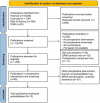Prehabilitation programs - a systematic review of the economic evidence
- PMID: 38105890
- PMCID: PMC10722222
- DOI: 10.3389/fmed.2023.1281843
Prehabilitation programs - a systematic review of the economic evidence
Abstract
Introduction: Prehabilitation, which involves improving a patient's physical and psychological condition before surgery, has shown potential benefits but has yet to be extensively studied from an economic perspective. To address this gap, a systematic review was conducted to summarize existing economic evaluations of prehabilitation interventions.
Methods: The PRISMA Protocols 2015 checklist was followed. Over 16,000 manuscripts were reviewed, and 99 reports on preoperative interventions and screening tests were identified, of which 12 studies were included in this analysis. The costs are expressed in Pounds (GBP, £) and adjusted for inflation to December 2022.
Results: The studies were conducted in Western countries, focusing on specific surgical subspecialties. While the interventions and study designs varied, most studies demonstrated cost savings in the intervention group compared to the control group. Additionally, all cost-effectiveness analysis studies favored the intervention group. However, the review also identified several limitations. Many studies had a moderate or high risk of bias, and critical information such as time horizons and discount rates were often missing. Important components like heterogeneity, distributional effects, and uncertainty were frequently lacking as well. The misclassification of economic evaluation types highlighted a lack of knowledge among physicians in prehabilitation research.
Conclusion: This review reveals a lack of robust evidence regarding the economics of prehabilitation programs for surgical patients. This suggests a need for further research with rigorous methods and accurate definitions.
Keywords: cost and cost analysis; economic evaluation; perioperative optimization; prehabilitation; preoperative care.
Copyright © 2023 Ke, Ng, Elangovan, Leong, Goh, Graves, Shannon and Abdullah.
Conflict of interest statement
The authors declare that the research was conducted in the absence of any commercial or financial relationships that could be construed as a potential conflict of interest.
Figures
Similar articles
-
Behavioural modification interventions for medically unexplained symptoms in primary care: systematic reviews and economic evaluation.Health Technol Assess. 2020 Sep;24(46):1-490. doi: 10.3310/hta24460. Health Technol Assess. 2020. PMID: 32975190 Free PMC article.
-
Recovery schools for improving behavioral and academic outcomes among students in recovery from substance use disorders: a systematic review.Campbell Syst Rev. 2018 Oct 4;14(1):1-86. doi: 10.4073/csr.2018.9. eCollection 2018. Campbell Syst Rev. 2018. PMID: 37131375 Free PMC article.
-
The future of Cochrane Neonatal.Early Hum Dev. 2020 Nov;150:105191. doi: 10.1016/j.earlhumdev.2020.105191. Epub 2020 Sep 12. Early Hum Dev. 2020. PMID: 33036834
-
The Economic Impact of Smoking and of Reducing Smoking Prevalence: Review of Evidence.Tob Use Insights. 2015 Jul 14;8:1-35. doi: 10.4137/TUI.S15628. eCollection 2015. Tob Use Insights. 2015. PMID: 26242225 Free PMC article. Review.
-
Evaluation of medical and health economic effectiveness of non-pharmacological secondary prevention of coronary heart disease.GMS Health Technol Assess. 2009 Dec 14;5:Doc16. doi: 10.3205/hta000078. GMS Health Technol Assess. 2009. PMID: 21289903 Free PMC article.
Cited by
-
Perioperative management of sarcopenia in patients undergoing major surgeries in Singapore: a modified Delphi consensus.Int J Surg. 2024 Aug 1;110(8):4552-4558. doi: 10.1097/JS9.0000000000001515. Int J Surg. 2024. PMID: 38701514 Free PMC article.
References
-
- Macmillan . (2023). Prehabilitation guidance for healthcare professionals. Available at: https://www.macmillan.org.uk/healthcare-professionals/news-and-resources...
LinkOut - more resources
Full Text Sources
Research Materials
Miscellaneous



